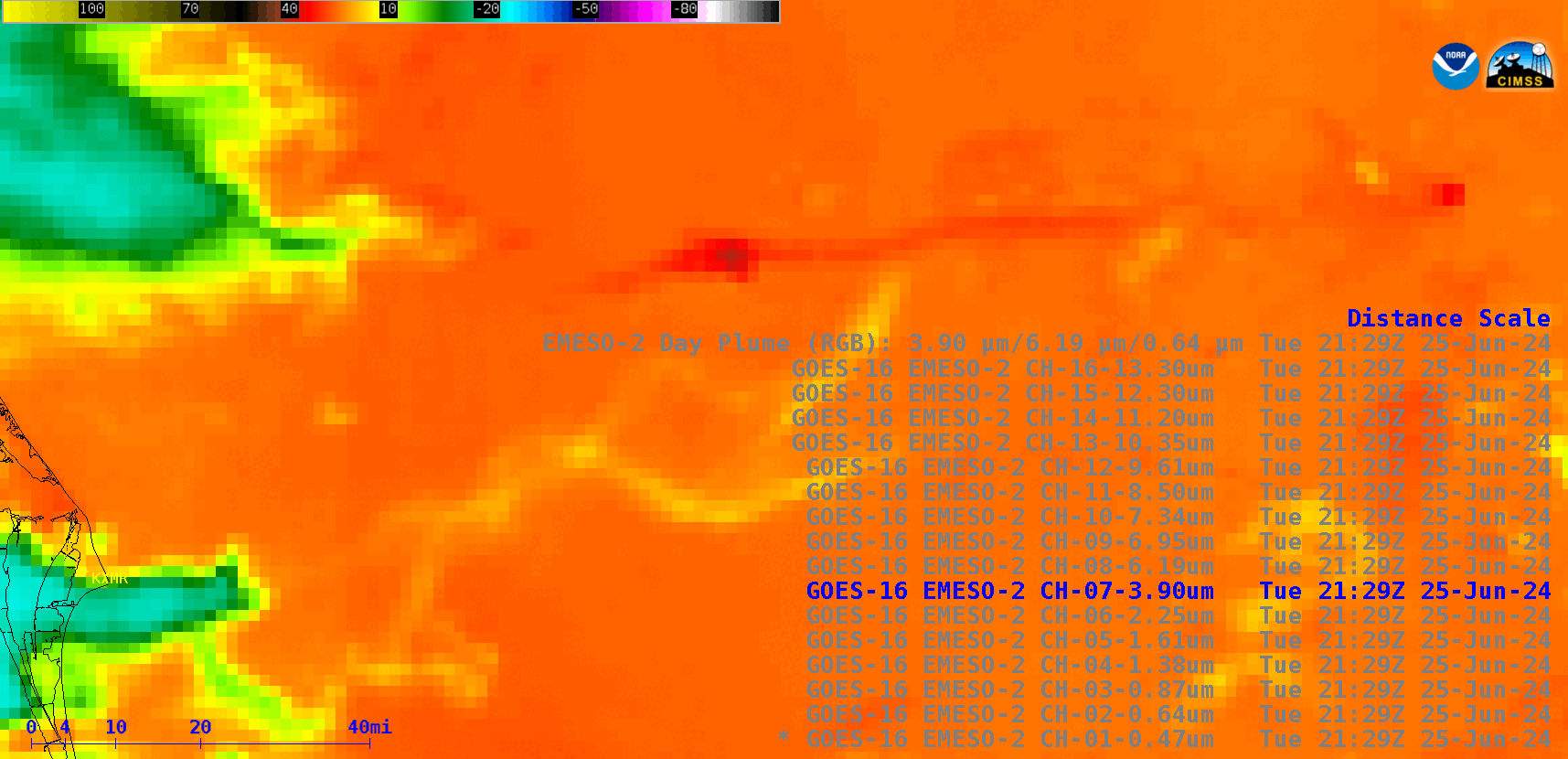
[ Archive ]

 |
CIMSS-NOAA Weekly Report [ Archive ] |
 |
CIMSS-NOAA WEEKLY HIGHLIGHTS FOR THE WEEK ENDING JUNE 28, 2024
DATA, INFORMATION, AND USE-INSPIRED SCIENCE:
CIMSS ADT and AiDT made available for NOAA Operations: The latest version of the Cooperative Institute for Meteorological Satellite Studies (CIMSS) ADT (Advanced Dvorak Technique) CCAP (Cloud Containerised Algorithm Package) was made available to NOAA ASSISTT for integration into NOAA operations in time for the 2024 hurricane season. ADT Version 9.1 includes important algorithm upgrades related to current and upcoming geostationary satellite platforms, including GOES-19 and Meteosat Third Generation, as well as integration of the latest version of ARCHER (Automated Rotational Center Hurricane Eye Retrieval) to provide the most accurate storm center determination to the ADT tropical cyclone intensity estimation algorithm. In addition, the machine learning-based AI-enhanced ADT (AiDT) was also made available. This effort supports the long-standing use of the ADT within NOAA operations and assures the latest science-based agorithm is available to NOAA tropical cyclone forecasters for years to come. (T. Olander, CIMSS, 608-265-8005,C. Velden, CIMSS, 608-262-9168)
FUTURE OUTLOOK:
AWARDS AND RECOGNITION:
TRAVEL AND MEETINGS:
GOES Presentation at AMS Broadcaster’s Conference: Chris Schmidt of the Cooperative Institute for Meteorological Satellite Studies (CIMSS) presented “Wildfires: Watching Them With GOES” at the American Meteorological Society’s (AMS) 51st Annual Conference on Broadcast Meteorology (BMC), held jointly with the 7th Conference on Weather Warnings and Communication, 12-14 June 2024 in Myrtle Beach, SC. This joint conference brought together television, radio, and online meteorologists, National Weather Service meteorologists and other civil servants, and vendors for training and networking opportunities. Given during the opening session of the joint conference, the talk focused on fire monitoring with the Advanced Baseline Imager (ABI) and the lower bounds of what can be seen visually and with algorithms. The audience was encouraged to ask their vendors, NOAA, and others for access to imagery of various products if they found them useful. The broadcasters often rely on internet sources for satellite imagery and products given the bandwidth limits on what is available through their vendors. There has been a GOES presence at the AMS BMC since 2014, and those educational opportunities have led to increased awareness of the satellite products and some expansion of the satellite offerings from the major vendors. (C. Schmidt, CIMSS, 608-262-7973)
Intersessional meetings of the ITWG: Intersessional meetings of the International TOVS Working Group (ITWG) are being held this summer. The Advanced Sounder Working Group (ASWG) held its meeting on June 27, with presentations and discussion covering a range of topics including the future Sterna mission, assessment and impact studies of the FY-3E Hyperspectral Infrared Atmospheric Sounder-II (HIRAS-II) data, use of Midwave and Shortwave Cross-track Infrared Sounder (CrIS) data in Numerical Weather Prediction, test data for the Meteosat Third Generation Infra-Red Sounder (MTG-IRS) instruments, and review of prior ASWG recommendations and actions. The meeting had 57 participants and was co-chaired by Dorothee Coppens of the European Organisation for the Exploitation of Meteorological Satellites (EUMETSAT) and David Tobin of the Cooperative Institute for Meteorological Satellite Studies (CIMSS). Meeting materials will be made available on the ITWG website. (D. Tobin, CIMSS, 608-265-6281)
TRAINING AND EDUCATION:
CIMSS Student Workshop completes another successful camp: For more than 30 years, the Cooperative Institute for Meteorological Satellite Studies (CIMSS) has offered a student weather workshop for students of high school age to learn about topics in meteorology and other geosciences. This year featured eighteen students from all across the US. The students arrived on Sunday June 23 and departed four days later on June 27. Discussion topics included hurricanes, severe weather and storm chasing, a McIDAS session where students presented their analysis of satellite-derived products, and a visit from National Weather Service Milwaukee/Sullivan Lead Meteorologist Marcia Cronce with a discussion on careers in NOAA. The students also spent time at the University of Wisconsin-Madison Planetarium and the Limnology lab with a boat trip on Lake Mendota to gather limnology data. The camp ended on the final day with a geology trip to Devils Lake for a couple of short hikes to see the unique geological features there. (D. Herndon, CIMSS, 608-262-6741)
CIMSS Presentation at AMS SATMOC Committee Short Course: John Cintineo (NOAA/NSSL) and Scott Lindstrom (Cooperative Institute for Meteorological Satellite Studies) presented information for an American Meteorological Society (AMS) Satellite Meteorology, Oceanography and Climatology (SATMOC) Committee short course. The short course topic was Using AI to predict convective hazards. Cintineo discussed the methods of creating Machine-learning tools to develop Probabilistic tools such as ProbSevere (version 3), LightningCast, and IntenseStormNet (all available in real time here: https://cimss.ssec.wisc.edu/severe_conv/psv3.html) and created google collaboration tools to demonstrate the framework for the development of LightningCast, as well as the relative importance of predictors is ProbSevere version 3 models. The short course was attended by about 180 people from around the globe. Classroom materials are online at this website: https://rammb2.cira.colostate.edu/training/2024-ams-satmoc-virtual-satellite-short-course/. (J. Cintineo, NSSL ; S. Lindstrom, CIMSS)
MEDIA INTERACTIONS AND REQUESTS:
SOCIAL MEDIA AND BLOG Posts:
CIMSS Satellite Blog Updates: Cooperative Institute for Meteorological Satellite Studies (CIMSS) Satellite Blog contributors Scott Bachmeier and Scott Lindstrom published the following case studies: "Satellite signatures of the GOES-U launch, from both GOES-16 and GOES-18" (June 25); "Severe thunderstorms across southern Wisconsin" (June 22); "Sheared Tropical System approaching the coast of Georgia" (June 21); "PHS information adds small-scale variability to initial fields" (June 21); "Hail swath near Willard, New Mexico" (June 19); "McDonald Fire in Alaska produces 2 pyrocumulonimbus clouds" (June 17). Read more at the CIMSS Satellite Blog (https://cimss.ssec.wisc.edu/satellite-blog/). (S. Lindstrom, CIMSS, 608-263-4425; S. Bachmeier, CIMSS; E. Verbeten, SSEC, 608-263-4206
 (Click image to enlarge)
(Click image to enlarge)
Figure: High-altitude thermal signatures of the SpaceX Falcon Heavy rocket booster that launched GOES-U on June 25, 2024 -- as seen in GOES-16 Shortwave Infrared, Water Vapor and Rocket Plume RGB images at 2129 UTC.
PUBLICATIONS:
OTHER:
| Archived Weeklies Page | Submit a report item |